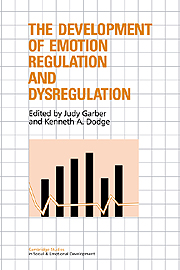Book contents
- Frontmatter
- Contents
- List of contributors
- Preface
- Part I Introduction
- Part II Early development
- Part III Physiological regulation
- Part IV Cognitive regulation
- Part V Psychopathology
- 11 Guilt and empathy: Sex differences and implications for the development of depression
- 12 Age changes in depressive disorders: Some developmental considerations
- Part VI Integration
- Author index
- Subject index
12 - Age changes in depressive disorders: Some developmental considerations
Published online by Cambridge University Press: 26 March 2010
- Frontmatter
- Contents
- List of contributors
- Preface
- Part I Introduction
- Part II Early development
- Part III Physiological regulation
- Part IV Cognitive regulation
- Part V Psychopathology
- 11 Guilt and empathy: Sex differences and implications for the development of depression
- 12 Age changes in depressive disorders: Some developmental considerations
- Part VI Integration
- Author index
- Subject index
Summary
The investigation of continuities and discontinuities between normality and abnormality is one of the central characteristics of a developmental psychopathology research perspective (Cicchetti & Schneider-Rosen, 1986; Garber, 1984; Masten & Braswell, in press; Plomin, in press; Rutter, 1986b, 1988; Rutter & Garmezy, 1983, Sroufe & Rutter, 1984). Psychiatry is full of examples in which this is a major issue (Rutter & Sandberg, 1985). Thus, it is necessary to ask whether the processes and mechanisms underlying anorexia nervosa, for example, are the same as those that apply to less extreme dieting behavior or whether the factors that influence levels and patterns of alcohol consumption in the general population also apply to alcohol dependence or abuse. But nowhere is this issue more apparent than in the field of depression. A degree of sadness or unhappiness is a normal part of the human condition, but does it have the same meaning as the misery that is part of a depressive psychosis with delusions of guilt and psychomotor retardation? A second defining feature of a developmental psychopathology research perspective is the concern with analyzing continuities and discontinuities over the life span as they apply to the development of disorders. Again, this is a key issue in the study of depression (Carlson & Garber, 1986; Cicchetti & Schneider-Rosen, 1986; Emde, Harmon, & Good, 1986; Rutter, 1986a, 1986b). We need to ask whether negative mood has the same meaning and is manifested in the same way at all stages of development.
- Type
- Chapter
- Information
- The Development of Emotion Regulation and Dysregulation , pp. 273 - 300Publisher: Cambridge University PressPrint publication year: 1991
- 15
- Cited by



